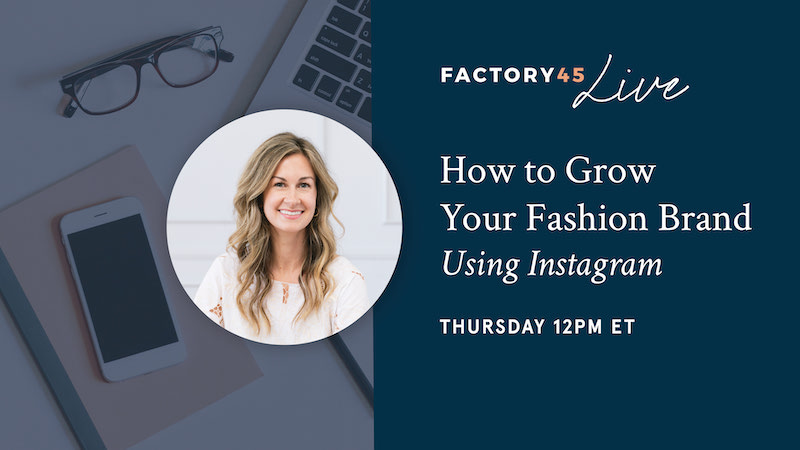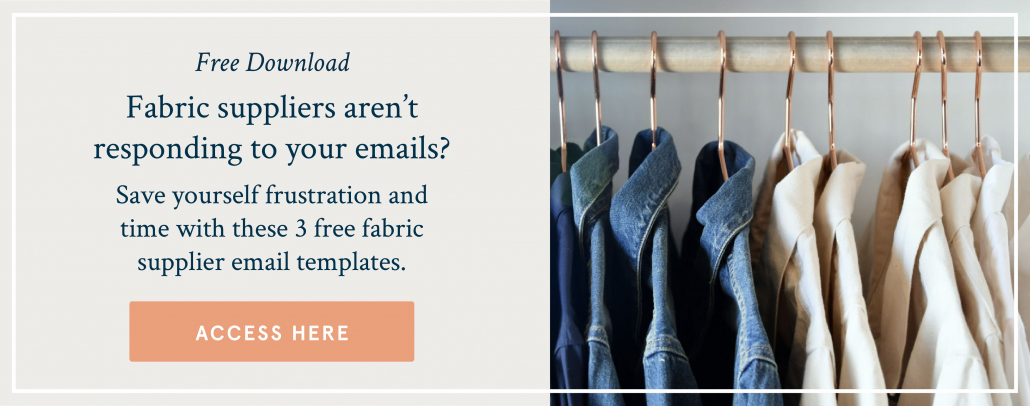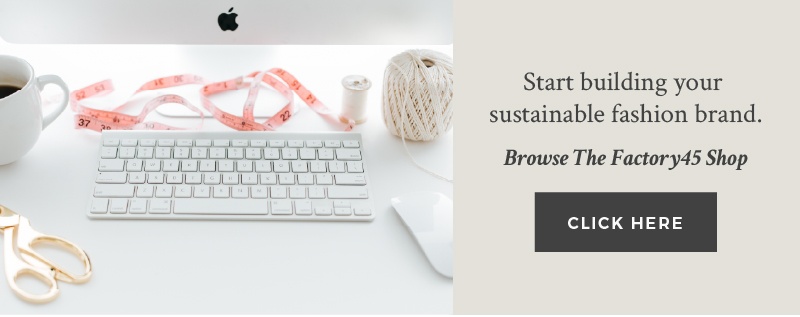Listen on Apple Podcasts | Listen on Spotify
You already know that you need an Instagram account for your fashion brand. But with algorithms always changing, the growth, reach and engagement can feel pretty slow and disappointing… in this episode, I’m sharing three key strategies to grow your following as a fashion startup on Instagram.
TRANSCRIPT
You already know that you need an Instagram account for your fashion brand. But with algorithms always changing, the growth, reach and engagement can feel pretty slow and disappointing… in this episode, I’m sharing three key strategies to grow your following as a fashion startup on Instagram.
Okay, so your Instagram account is up and running for your brand. You know you need great photography, to post to your grid and Stories consistently, as well as a bio section that engages your ideal target customer and gives them a call to action.
Oh, you didn’t know that?
Okay, let’s quickly review:
First, great photography. Whereas high-quality photography has become less important across Instagram as a whole (hashtag authenticity). It’s still pretty important for a fashion brand. Fashion is so much about aesthetics, image and feeling that you really can’t get away with posting a dark, grainy photo to your Instagram grid. General rule of thumb, keep your grid polished and consistent and save the grittier, more raw photos for Instagram Stories where they’ll disappear after 24 hours. You can think of it this way: your Instagram grid is your magazine and your IG Stories is your journal.
The second thing I mentioned is consistency. If you’re really serious about growing your Instagram following and not just using Instagram as a place to showcase, then you have to be consistent about your posting schedule. Otherwise, the algorithm will kill you. Instagram is specifically designed to reward the accounts that post frequently and predictably and to penalize the accounts that post inconsistently and infrequently. They do this through post reach. So the more regularly you post, the more your content will be seen by your followers. The opposite is true, as well, if you’re not posting regularly that your reach will drop and your content will be seen by a miniscule fraction of your audience.
I know, cue anxiety attack. I’m not telling you this so that you’re pushed to be further addicted to your phone and the platform, but more so that you know how important it is to have a posting schedule and plan in place which I’ll talk more about in a minute.
The third thing (and we haven’t even gotten into the three strategies I’m going to teach on this episode yet) is your bio section. When you go to your profile this is the little area under your profile picture and follower count where you can add text and one link. Use that text area to give a very clear and compelling one-sentence description of your brand and then make sure you include a CTA or call to action directing people to the link. If you haven’t launched yet then you’ll want to direct people to your landing page where they can sign up to your email list. If you’re currently selling then this link will go to your online store to shop.
Okay, so with all of that said, let’s get into three main strategies that I want to tell you about today. Let’s say you have a few hundred followers already but you’re having a hard time figuring out how to actually grow your following…
STRATEGY #1 is to CREATE A CONTENT CALENDAR
You may have heard this one before, and I’ve already hinted at it, but it truly can’t be emphasized enough. You *need* to create a content calendar.
Why? Because as I’ve already said, Instagram growth is all about consistency.
And what’s the #1 way to make sure you’re consistent in posting? Creating a plan in advance and scheduling your content.
Your content calendar does not need to be a complicated spreadsheet with 17 different tabs. Simply come up with 5 content pillars to start. Write them down and then break up those 5 content pillars into smaller topics.
So, one content pillar could be Your Ideal Customer — one topic under that pillar could be the rave reviews you get through your ecommerce store, in your Instagram DMs or in Facebook comments. Turn those short testimonial quotes into graphics that can be posted in your Instagram feed. Another topic under the same pillar could be photos of your customers wearing your products.
When it comes to your Instagram posts on your grid, it’s about quality over quantity. So you don’t need to post to your feed every day. Make a plan to post on Mondays and Fridays or Wednesdays and Sundays and put it into your content pillar with your 5 Pillars.
Once you have the content and are ready to write the captions you can simply use Planoly or Later (both are scheduling apps for Instagram) to schedule your posts. You’ll want to find out when your followers are most active and engaged so that you can schedule your posts around those times.
For Instagram Stories, you can keep those same 5 pillars and sub topics but again, you don’t have to worry as much about quality. Make a point to try to post to Stories every day, or as consistently as you can. The point here is to create a plan and stick to it.
STRATEGY #2 is to CREATE SHAREABLE CONTENT
One of the most likely reasons that your Instagram account isn’t growing is because you’re not creating shareable content. Instagram in itself is not a discovery platform anymore — it’s really hard to be exposed to new followers organically.
That means that new followers will most likely find you through other people who also follow you. You can elevate this discovery mechanism by creating shareable content.
There are two types of shareable content that are more likely to be reposted by other accounts. And those are Quotes and Infographics. These are easily digestible pieces of content that your ideal target customer would connect with and repost or share.
Another great way to create shareable content is through cross promotion, partnerships and giveaways with like-minded brands and/or influencers that aren’t direct competitors. You can create content that you encourage other people to share or repost and get discovered by new followers.
And this last strategy is my favorite one — it’s
STRATEGY #3: AUDIENCE GENERATED CONTENT
What does that mean? It means that your customers create content for you. They post photos or videos wearing or using your products and tag you so you can repost or reshare.
A really good example of this is one of my Factory45 entrepreneurs, Fair Seas Supply Co. As soon as the founder, Tiffany, had samples of her organic cotton beach blankets she sent them out to women who were her ideal target customer. She asked them to take photos using the blanket and mention Fair Seas Supply Co. in their Instagram caption. This also generated dozens of beautiful images that she could then repost the photos to her own Instagram account.
Here’s the thing, your audience will likely make more compelling content than you can. Professional photoshoots are important but they’re not necessarily what potential customers want to see on Instagram anymore. People are craving authenticity and realness online, and they want to see real people like them, using or wearing your product.
You can take this strategy up a notch, once you’re continuously selling, by offering incentives to customers to share pictures of your product through contests or giveaways with the chance to win a gift card or something else. Challenges are another great way to give your customer something to do, post the photo and use a special hashtag you give them so you can find it.
When it comes to audience generated content the options are virtually endless.
Okay, so there are three strategies: Content Calendar, Shareable Content and Audience-Generated Content that you can tweak and apply to your own stage of business — even if you haven’t launched your brand yet. The goal here is to ask yourself “What does my customer want to see, hear, watch or connect with on Instagram? What provides value, inspiration or entertainment to them that my brand can provide?
This takes experimentation and persistence. You have to look at the data — what types of posts / Stories / videos etc. get the most engagement? How can you double down and do more of what’s working and scrap what isn’t working?
Remember that this will be an always evolving work in progress so enjoy the journey while you’re in, appreciate every new follower that comes your way and keep going.
Are you working behind the scenes to start a sustainable fashion brand? Maybe you’re working a full-time job and pursuing your brand as a “side hustle” — that’s our favorite type of entrepreneur to work with. If you’re interested in learning more about not only starting, but actually launching, your fashion brand with Factory45, book a call to learn more about working with us. Click the image below to book a call. We’d love to chat and hear more about your business goals.
























